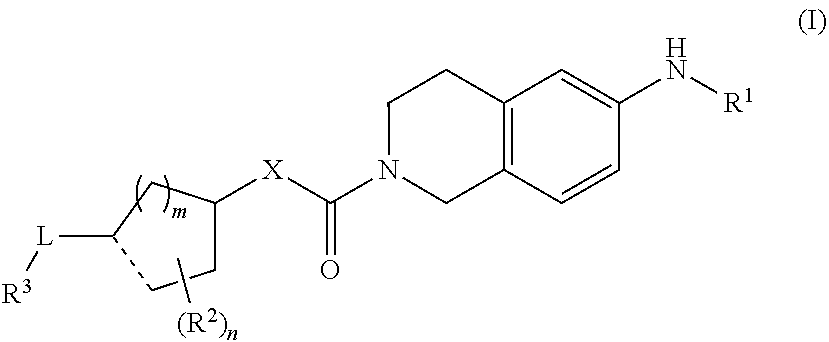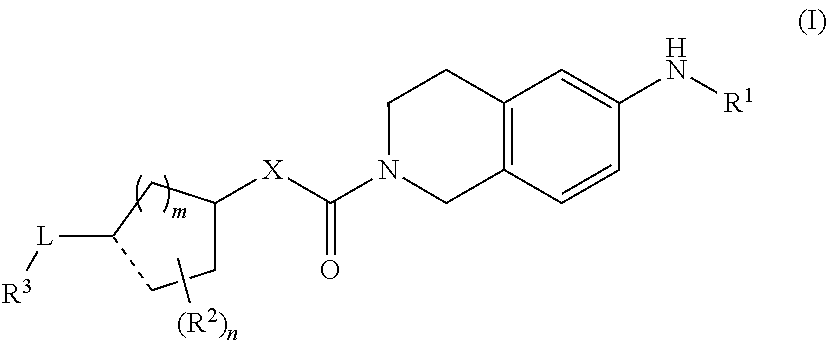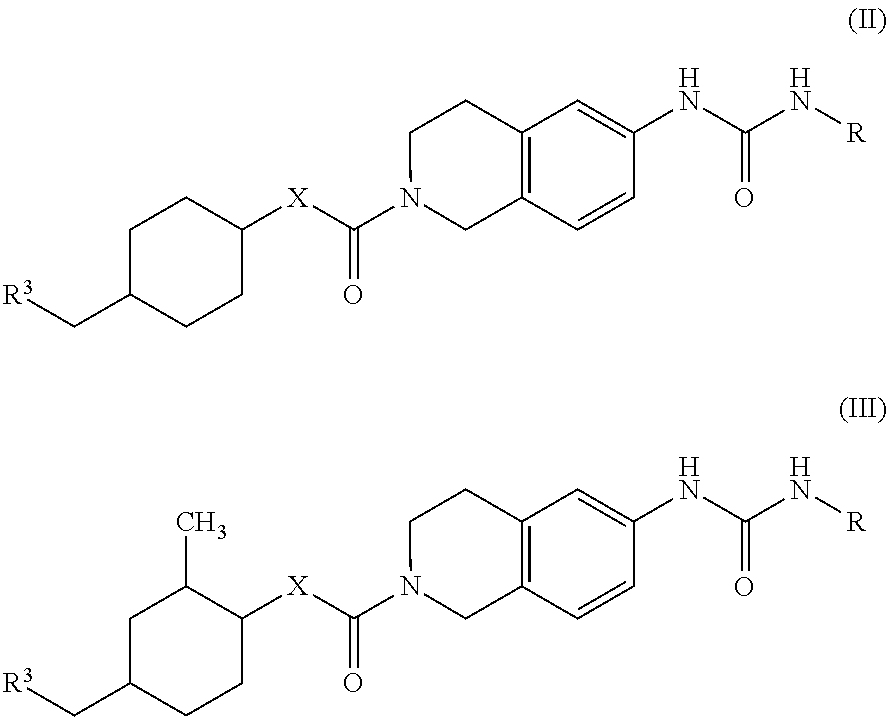Novel tetrahydroisoquinoline derivative
a technology of isoquinoline and derivative, which is applied in the field of new tetrahydroisoquinoline derivative, can solve the problems of life-threatening clinical conditions, adverse effects of centrally acting anorectics, and low treatment satisfaction of drugs, and achieve excellent dgat inhibitory
- Summary
- Abstract
- Description
- Claims
- Application Information
AI Technical Summary
Benefits of technology
Problems solved by technology
Method used
Image
Examples
example 1
trans-6-[3-(2-fluoro-phenyl)-ureido]-3,4-dihydro-1H-isoquinoline-2-carboxylic acid 4-methoxycarbonylmethyl-cyclohexyl ester
[0361]
(1a) (1,4-dioxa-spiro[4.5]dec-8-ylidene)-acetic acid methyl ester
[0362]To a DMF (50 mL) solution of trimethyl phosphonoacetate (26 mL), sodium hydride (purity: 55% or higher, 7.03 g) was added in small portions at 0° C. The reaction mixture was warmed to room temperature and stirred for 30 minutes. A DMF (50 mL) solution of 1,4-cyclohexanedione monoethylene ketal (25.2 g) was added, thereto in small portions at room temperature. This suspension was stirred for 19 hours and diluted with a saturated aqueous solution of ammonium chloride, followed by two extractions with ethyl acetate. The organic layer was washed with saturated brine, then dried over sodium sulfate, and then concentrated. The residue was purified by chromatography (hexane / ethyl acetate=5:1) to obtain the title compound (29.7 g, 87%) as a colorless oil.
[0363]1H NMR (400 MHz, CDCl3): δ (ppm)=5...
example 2
trans-6-[3-(2-fluoro-phenyl)-ureido]-3,4-dihydro-1H-isoquinoline-2-carboxylic acid 4-carboxymethyl-cyclohexyl ester
[0377]
[0378]To a 1,4-dioxane (20 mL) mixture of trans-6-[3-(2-fluoro-phenyl)-ureido]-3,4-dihydro-1H-isoquinoline-2-carboxylic acid 4-methoxycarbonylmethyl-cyclohexyl ester (1.48 g) obtained in Example 1, tetrabutylammonium hydroxide (1.0 mol / L aqueous solution, 4.0 mL) was added at room temperature. The reaction mixture was stirred for 22 hours and concentrated. The residue was acidified with a 1N aqueous hydrochloric acid solution (30 mL), then diluted with ethyl acetate, and vigorously stirred until complete dissolution. The separated organic layer was washed with saturated brine, then dried over sodium sulfate, and then concentrated. The residue was purified by chromatography (dichloromethane / methanol). The obtained solid was recrystallized (isopropyl alcohol) to obtain the title compound (1.04 g, 72%) as a white solid.
[0379]1H NMR (400 MHz, DMSO-d6): δ (ppm)=12.1 (1...
example 3
cis-6-[3-(2-fluoro-phenyl)-ureido]-3,4-dihydro-1H-isoquinoline-2-carboxylic acid 4-carboxymethyl-cyclohexyl ester
[0381]
[0382]Methyl ester (143 mg, quantitative yield) was obtained in the same way as in Example (1e) from cis-(4-hydroxy-cyclohexyl)-acetic acid methyl ester (62 mg) obtained in Example (1d) and 1-(2-fluoro-phenyl)-3-(1,2,3,4-tetrahydro-isoquinolin-6-yl)-urea hydrochloride (WO2006004200 A1) (83 mg). This methyl ester was hydrolyzed in the same way as in Example 2 to obtain the title compound (86 mg, 71%) as a white solid.
[0383]1H NMR (400 MHz, DMSO-d6): δ (ppm)=12.0 (1H, s), 9.01 (1H, s), 8.53 (1H, s), 8.16 (1H, dd, J=9.0 and 9.0 Hz), 7.35-6.95 (6H, m), 4.85-4.77 (1H, m), 4.58-4.39 (2H, m), 3.66-3.53 (2H, m), 2.82-2.74 (2H, m), 2.17 (2H, d, J=7.0 Hz), 2.20-2.08 (1H, m), 1.82-1.69 (3H, m), 1.59-1.47 (3H, m), 1.38-1.22 (2H, m);
[0384]MS (ESI) m / z: 469 (M+H)+.
PUM
| Property | Measurement | Unit |
|---|---|---|
| reaction time | aaaaa | aaaaa |
| reaction time | aaaaa | aaaaa |
| reaction time | aaaaa | aaaaa |
Abstract
Description
Claims
Application Information
 Login to View More
Login to View More - R&D
- Intellectual Property
- Life Sciences
- Materials
- Tech Scout
- Unparalleled Data Quality
- Higher Quality Content
- 60% Fewer Hallucinations
Browse by: Latest US Patents, China's latest patents, Technical Efficacy Thesaurus, Application Domain, Technology Topic, Popular Technical Reports.
© 2025 PatSnap. All rights reserved.Legal|Privacy policy|Modern Slavery Act Transparency Statement|Sitemap|About US| Contact US: help@patsnap.com



